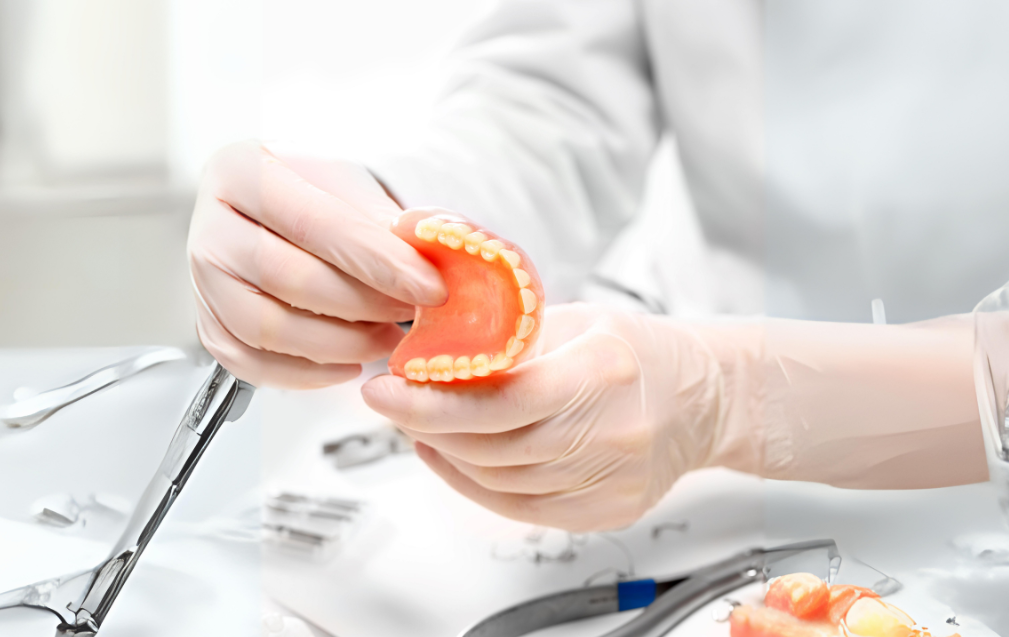A Guide to Partial Dentures: Everything You Need to Know

Partial dentures can be a life-changing solution for people missing one or more teeth. They’re tailored to fill in the gaps in your smile, improving your oral health, appearance and self-confidence in the process. These dentures are designed using a wide variety of materials including acrylic, chrome, flexible variants and even 3D-printed dentures. Each type offers unique benefits, so learning about the differences can help guide the choice you make when it comes to partial dentures. So, in this article, we’ll offer you a guide to partial dentures that will cover everything you need to know.
Types of Partial Dentures
There are a few different types of partial dentures that you’ll likely consider before making a final decision. Below is a breakdown of the most common types and their benefits.
Acrylic Partial Dentures
The most common type of partial dentures are made using acrylic due to their affordability and ease of adjustment. These dentures consist of replacement teeth attached to a gum-coloured plastic base, connected by a framework.
Acrylic dentures are lightweight and can be crafted quickly, making them a great option for temporary or emergency tooth replacement.
Chrome Partial Dentures
Chrome partial dentures are known for their strength and durability. Made from a cast metal framework, they offer a snug fit and excellent support to the remaining natural teeth.
Chrome dentures are less bulky than acrylic ones and provide a comfortable wearing experience. They are also less visible, as the thinner framework is designed to be slightly less obtrusive in the mouth.
Flexible Partial Dentures
Flexible partial dentures are made from a thin plastic material, such as nylon, which is both comfortable and aesthetically pleasing.
The flexibility allows these dentures to adapt to the contours of the mouth, providing a natural appearance without the use of metal clasps. They are a good choice for patients looking for a lightweight and hypoallergenic option.
3D Printed Partial Dentures
The newest addition to denture technology is 3D-printed partial dentures. These are created using digital dental technology that provides a precise fit and faster production times.
This method allows for highly customised dentures that can replicate the natural look of teeth and gums more accurately. 3D-printed dentures are also typically stronger and more durable than those made with traditional methods.
How Partial Dentures Can Impact Your Daily Life
Partial dentures not only fill the gaps left by missing teeth but also help maintain the shape of your face, preventing the facial muscles from sagging. This can significantly enhance your appearance and boost your confidence.
Opting for partial dentures can also help with speech issues that stem from missing teeth. Missing teeth can impair your ability to pronounce certain words or speak clearly. Filling these gaps with dentures can help improve your speech, making communication easier and more effective.
Eating with Partial Dentures
It can take some time to get used to eating with new partial dentures. Start with soft foods cut into small pieces, and chew slowly using both sides of your mouth. As you adjust, you can gradually introduce more varied textures into your diet. Avoid sticky or very hard foods that may dislodge the dentures. Use a small amount of denture adhesive to help stabilise the dentures as you eat.
Be cautious with hard foods like nuts and seeds, as well as sticky and hard-boiled sweets. Hot beverages and foods can also cause discomfort as they may alter the fit of the dentures temporarily due to heat.
Adjusting to Wearing Partial Dentures
Expect a period of adjustment where the dentures may feel awkward or uncomfortable. During the first few weeks, it’s common to experience minor irritation or soreness while your mouth adapts to the partial dentures. Saliva production may increase temporarily, and you might find yourself speaking differently. Practise reading aloud and speaking in front of a mirror to adjust more quickly.
How to Properly Clean Your Partial Dentures
Rinse your dentures after eating to remove food debris. Brush them daily with a soft-bristled brush and a non-abrasive cleaner to keep them free of plaque. Use brushes designed for dentures and a mild denture cleanser. Avoid using toothpaste, as it can be too harsh for the denture materials.
The cleaning process for your partial dentures should be regimented to keep them in good condition. Below is a step-by-step breakdown of this process for you to use:
• Rinse Dentures: You should rinse your partial dentures with water after every meal to remove food debris.
• Clean Your Mouth: After removing your dentures, use a soft-bristled brush on your natural teeth and a soft toothbrush for your tongue, cheeks and the roof of your mouth.
• Brush Daily: Daily cleaning is essential if you want to keep your partial dentures in good condition. Soaking and brushing them with a soft-bristled brush and denture cleanser is the best approach.
• Soak Your Dentures: You should be soaking your partial dentures overnight when you’re not using them. Use a mild denture-soaking solution overnight to help them keep their shape.
• Rinse Your Dentures: Before putting them back in your mouth, make sure that you rinse your dentures thoroughly to remove any denture-soaking solution.
To avoid damage and wear, handle your dentures carefully. Regular check-ups with your dentist are important to ensure they continue to fit well and remain in good condition. Always store them in water or a denture solution when not in use to keep them moist.If you’re considering partial dentures then get in touch with our team of experts at Denturly. Book a consultation with us today for more information or to get started with fitting your new dentures.
View our denture clinics
Find a Denturly clinic near you. We are always expanding our nationwide network of clinics to make our service more accessible.